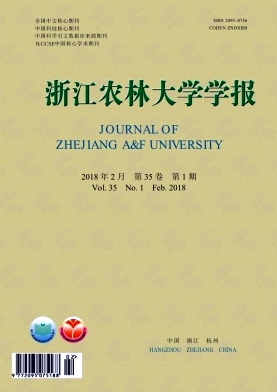-
生物固氮是自然界植物利用氮素的重要途径,固氮植物通过与根瘤形成的共生固氮体系[1],不仅为固氮植物提供氮素,而且在土壤改良及农业可持续发展中有着不可低估的作用[2-3]。大量研究表明,生物固氮是生态系统中有效氮的主要来源,据统计,地球上由豆科Leguminosae根瘤菌固定的氮素达8×1010 kg·a-1,约占全球生物固氮总量的40%,相当于全世界工业合成氮肥量的2倍[4]。自20世纪90年代以来,国内外陆续开展了固氮植物资源的调查研究,表明豆科植物是主要的固氮植物,1.8万种豆科植物中(含羞草亚科Mimosoideae逾0.28万种,苏木亚科Caesalpinioideae逾0.28万种,蝶形花亚科Papilionoideae逾l.20万种),98%的含羞草亚科、63%的蝶形花亚科及30%的苏木亚科植物能结瘤固氮,非豆科共生固氮植物相对较少[5-8]。调查发现毛竹Phyllostachys edulis林下植物资源较为丰富[9],但对毛竹林下固氮植物资源的调查少有涉及。毛竹是中国重要的经济竹种,分布区域广,栽培面积大,应用范围广,经济价值高,是中国南方毛竹主产区竹农的重要经济来源,也是区域社会经济发展的重要资源和生态屏障。氮是毛竹生长所需要的重要营养元素,林地氮素补充对毛竹林出笋率、立竹胸径和产量均有促进作用[10-12],季节性施肥是毛竹林丰产栽培的重要措施,尤其是施加氮肥。然而,长期过量施肥会导致毛竹林土壤养分失衡、酸化、板结、有害物质积累及生物多样性降低、竹材和竹笋产量与质量下降等负面影响。简单地依靠施氮肥为主的方式来提高竹林产品产量和品质,已经不能保障毛竹林立地生产力的稳定和生态系统完整性的维护,尤其是在当前毛竹林产品市场疲软,竹林经营效益大幅度下降,竹农经营毛竹林的积极性受到严重影响的背景下,如何系统地调查毛竹林下固氮植物资源,筛选生态适应性强、投入少、见效快、经济价值高、市场前景大的固氮植物种类,构建毛竹林下固氮植物高效复合经营模式,提高毛竹林自肥能力,对毛竹林可持续经营以及提高竹农经济收入等有着重要作用。基于此,笔者采取踏查法对浙江、福建毛竹主产区的毛竹林下固氮植物进行了调查,并对其经济价值进行了分析。
HTML
-
2015年8-9月、2016年7-8月在浙江省龙游县、景宁县、桐庐县、富阳区、江山市和福建省沙县等毛竹主要分布区采用踏查法对人为干扰相对较小、林下植被较为丰富的毛竹林下固氮植物进行调查记录,并通过万方数据资源检索补充毛竹林下固氮植物种类。毛竹林下固氮植物生活型、经济价值、药用部位皆参考于《中国植物志》。调查数据用Word 2003统计软件进行处理。
-
毛竹林下固氮植物种类较为丰富,共有4科23属41种(表 1)。其中,豆科(含羞草亚科、苏木亚科、蝶形花亚科3个亚科)20属35种,占毛竹林下固氮植物种类的85.37%。豆科中含羞草亚科和苏木亚科种类较少,蝶形花亚科种类较多,达17属31种,占毛竹林下固氮植物种类的75.61%。毛竹林下非豆科固氮植物有胡颓子科Elaeagnaceae,大戟科Euphorbiaceae和杨梅科Myricaceae等3个科,胡颓子属Elaeagnus有4种,占9.76%,算盘子属Glochidion和杨梅属Myrica各有1属,各占2.44%。

Table 1. Species of nitrogen-fixing plants under Phyllostachys edulis stands
-
生活型是植物适应外界环境的形态表现。由表 2可知:毛竹林下固氮植物类型有乔木、灌木、草本和藤本。其中,乔木有2科5属7种,占毛竹林下固氮植物种类的17.07%,灌木、草本、藤本分别有3科9属20种、1科7属5种、1科5属9种,分别占毛竹林下固氮植物种类的53.66%,14.63%和21.95%。可见,毛竹林下固氮植物主要为灌木类型,乔木、草本和藤本分布相对较少。
生活型 科 属 种 科数/科 占总科数的比例/% 属数/属 占总属数的比例/% 种数/种 占总种数的比例/% 乔木 2 50.00 5 21.74 7 17.07 灌木 3 75.00 9 39.13 20 48.78 草本 1 25.00 7 30.43 5 12.20 藤本 1 25.00 5 21.74 9 21.95 Table 2. Life form of nitrogen-fixing plants under Phyllostachys edulis stands
生态型是植物物种对其生境的基因方面的反应。由表 3可知:毛竹林下固氮植物有旱生、中生、湿生等3种生态型,其中,中生植物3科16属28种,占毛竹林下固氮植物种类的68.29%,旱生和湿生植物分别有1科3属6种、2科7属7种,分别占毛竹林下固氮植物种类的14.63%和17.07%。可见毛竹林下固氮植物主要为中生型,湿生和旱生分布较少。
生态型 科 属 种 科数/科 占总科数的比例/% 属数/属 占总属数的比例/% 种数/种 占总种数的比例/% 旱生 1 25 3 13.04 6 14.63 中生 3 75 16 69.57 28 68.29 湿生 2 50 7 30.43 7 17.07 Table 3. Ecotype of nitrogen-fixing plants under Phyllostachys edulis stands
-
毛竹林下固氮植物具有诸多方面的经济价值,如药用、食用、饲料、肥料等(表 4)。其中,调查到的毛竹林下固氮植物都具有药用价值,具有食用价值的种类有3科16属23种,占毛竹林下固氮植物种类的56.10%,可以用于饲料、肥料的分别有2科9属10种、1科7属7种,分别占毛竹林下固氮植物种类的24.39%和17.07%,此外,具有香料、化工等其他经济价值的有1科8属12种,占毛竹林下固氮植物种类的29.27%。具有2种以上多重经济价值的种类有3科21属31种,占毛竹林下固氮植物种类的75.61%。说明毛竹林下固氮植物具有很好的开发利用潜力。
经济价值 科 属 种 科数/科 占总科数的比例/% 属数/属 占总属数的比例/% 种数/种 占总种数的比例/% 药用 4 100.00 23 100.00 41 100.00 食用 3 75.00 16 69.57 23 50.10 饲料 2 50.00 9 39.13 10 24.39 肥料 1 25.00 7 30.43 7 17.07 其他 1 25.00 8 34.78 12 29.27 多重价值 3 75.00 21 91.30 31 75.61 Table 4. Economic value of nitrogen-fixing plants under Phyllostachys edulis stands
-
从表 5可知:毛竹林下固氮植物的药用部位有根、茎、叶、花、果实、种子、全株。其中,根药用的最多,茎次之,种子最少。根、茎、叶营养器官药用的分别有4科15属19种、4科11属15种和3科5属8种,分别占毛竹林下固氮植物种类的46.34%,36.59%和19.51%。花、果实、种子生殖器官药用的分别有1科6属7种、3科3属6种和2科3属3种,分别占毛竹林下固氮植物种类的17.07%,14.63%和7.32%。整株可药用的有1科7属12种,占毛竹林下固氮植物种类的29.27%。总体而言,毛竹林下固氮植物按入药部位分,其种类多少排序为根>茎>全株>叶>花>果实>种子。
药用部位 科 属 种 科数/科 占总科数的比例/% 属数/属 占总属数的比例/% 种数/种 占总种数的比例/% 根 4 100.00 15 65.22 19 46.34 茎 4 100.00 11 47.83 15 36.59 叶 3 75.00 5 21.74 8 19.51 花 1 25.00 6 26.09 7 17.07 果实 3 75.00 3 13.04 6 14.63 种子 2 50.00 3 13.04 3 7.32 全株 1 25.00 7 30.43 12 29.27 Table 5. Medicinal parts of nitrogen-fixing plants under Phyllostachys edulis stands
2.1. 毛竹林下固氮植物种类
2.2. 毛竹林下固氮植物生活型及生态型
2.3. 毛竹林下固氮植物经济价值分析
2.4. 毛竹林下固氮植物药用部位多样性
-
调查结果表明:毛竹林下固氮植物共有4科23属41种,主要为豆科植物,而且以蝶形花亚科种类为主。毛竹林下固氮植物有旱生、中生、湿生3种生态型,并且以中生为主,存在乔木、灌木、草本和藤本4种生活型,其中以灌木类型种类居多,说明灌木类固氮植物比其他类型的固氮植物更能适应毛竹林下环境,这与毛竹林劈山除草等人为经营干扰会导致一些林下植物生命过程破坏,难以完成完整的生殖过程有关[15],也与区域毛竹林经营中施用化学除草剂,清除了大量的林下植被,使乔木、草本、藤本类植物失去更新生长的竞争能力,有利于灌木生长等有关[16]。
毛竹林下固氮植物具有药用、食用、饲料、肥料等经济价值,所调查的全部固氮植物皆具有药用价值,1/2以上的种类具有食用价值,1/5左右的种类可用于饲料、肥料,而且兼具药用、食用、饲料、肥料等2种以上经济价值的种类约占4/5。毛竹林下固氮植物药用器官有根、茎、叶、花、果实、种子,有的可全株入药,其中,根部药用最多,种子药用最少。可见,结合毛竹及其林下固氮植物的生物学和生态学特性以及与环境之间的关系,科学合理的提出毛竹林下种植固氮植物的种类配比、空间配比、时间配比,选中最佳坡向坡位坡度,并结合不同的人为干扰,研究构建毛竹林下固氮植物复合经营模式,对于提高林地使用率和产出率,充分发挥毛竹林的经济、生态功能具有重要作用。








 DownLoad:
DownLoad: